Analysis of Pre-Earthquake Ionospheric Anomalies in the Japanese Region Based on DEMETER Satellite Data
Abstract
1. Introduction
2. Data and Shock Example Screening
3. Analysis Process
4. Analysis Results and Discussion
4.1. Construction of Background Fields and Seismic-Free Comparison Tests
4.2. Earthquake Example 1
4.3. Earthquake Example 2
4.4. Earthquake Example 3
4.5. Earthquake Example 4
4.6. Anomalies Collation
5. Conclusions
- (1)
- Background characteristics
- a.
- By constructing the background fields of the earthquake cases, it can be seen that Ne, Ni, and Te all have a variation pattern with increasing latitude, and this pattern is more evident for Te and the relatively high correlation between Ne and Ni.
- b.
- Most of the nocturnal electron concentration values are distributed between , most of the ion concentration values are between , and most of the electron temperature values are between .
- c.
- In the case of calm and non-seismic space weather, the perturbation intensity of the three-parameter data relative to the background data is around 1, i.e., no anomalies above 3σ occur in the non-seismic case.
- (2)
- Anomalies:
- a.
- In the four cases studied in this paper, Ne showed anomalies exceeding 3σ, three cases showed Ni and Te anomalies, where Ne and Ni were either anomalously enhanced or weakened before the earthquake, and Te showed anomalous enhancement.
- b.
- Based on the four earthquake cases, it can be seen that in space, the abnormal enhancement phenomenon of Ne appears in the north of the epicenter, and the abnormal weakening phenomenon appears in the south of the epicenter. The anomalies of Ni and Te are not significantly related to the orientation. In terms of time, the ionospheric anomalies in the three cases appear 9–12 days before the earthquake, and the anomaly in Case 3 appears on the third day before the earthquake. By plotting the variation curves of ionospheric parameters with time, we can obtain that the anomalies can still be captured fifteen days before the earthquake in some cases, which indicates to a certain extent that the earthquake incubation time is more than fifteen days. The spatial orientation and time of the anomalies in the cases studied in this paper show that the earthquake precursors in the same area are also diverse.
- c.
- For the analysis of the individual earthquake cases, the time and location of the anomalies of the three parameters have a high consistency, especially the anomalous synchronization of Ne and Ni in the same area simultaneously. Combined with the experimental results under no-earthquake conditions, it is reasonable to suggest that there may be a correlation between the occurrence of these anomalies and earthquake incubation.
Author Contributions
Funding
Data Availability Statement
Acknowledgments
Conflicts of Interest
References
- Chmyrev, V.M.; Isaev, N.V.; Bilichenko, S.V.; Stanev, G. Observation by space-borne detectors of electric fields and hydromagnetic waves in the ionosphere over an earthquake centre. Phys. Earth Planet. Inter. 1989, 57, 110–114. [Google Scholar] [CrossRef]
- Molchanov, O.A.; Mazhaeva, O.A.; Golyavin, A.N.; Hayakawa, M. Observation by the Intercosmos-24 satellite of ELF-VLF electromagnetic emissions associated with earthquakes. Ann. Geophys. 1993, 11, 431–440. [Google Scholar]
- Pulinets, S.A.; Legen’ka, A.D. Spatial-temporal characteristics of the large scale disturbances of electron concentration observed in the F-region of the ionosphere before strong earthquakes. Cosmic Res. 2003, 41, 221–229. [Google Scholar] [CrossRef]
- Parrot, M.; Benoist, D.; Berthelier, J.; Błęcki, J.; Chapuis, Y.; Colin, F.; Elie, F.; Fergeau, P.; Lagoutte, D.; Lefeuvre, F.; et al. The magnetic field experiment IMSC and its data processing onboard DEMETER: Scientific objectives, description and first results. Planet. Space Sci. 2006, 54, 441–455. [Google Scholar] [CrossRef]
- Yan, X.X.; Shan, X.J.; Cao, J.B.; Tang, J. Statistical analysis of electron density anomalies before global M7.0 earthquakes (2005–2009) using data of DEMETER satellite. Chin. J. Geophys. 2014, 57, 364–376. (In Chinese) [Google Scholar]
- Parrot, M.; Berthelier, J.; Lebreton, J.; Sauvaud, J.; Santolik, O.; Blecki, J. Examples of unusual ionospheric observations made by the DEMETER satellite over seismic regions. Phys. Chem. Earth Parts A/B/C 2006, 31, 486–495. [Google Scholar] [CrossRef]
- Zeng, Z.C.; Zhang, B.; Fang, G.Y. The analysis of ionospheric variations before Wenchuan earthquake with DEMETER data. Chin. J. Geophys. 2009, 52, 11–19. (In Chinese) [Google Scholar] [CrossRef]
- Xinyan, O.U.; Xuemin, Z.H.; Xuhui, S.H.; Jianping, H.U.; Jing, L.I.; Zhima, Z.E.; Shufan, Z.H. Disturbance of O+ density before major earthquake detected by DEMETER satellite. Chin. J. Space Sci. 2011, 31, 607–617. (In Chinese) [Google Scholar]
- Berthelier, J.; Godefroy, M.; Leblanc, F.; Malingre, M.; Menvielle, M.; Lagoutte, D.; Brochot, J.; Colin, F.; Elie, F.; Legendre, C.; et al. ICE, the electric field experiment on DEMETER. Planet. Space Sci. 2006, 54, 456–471. [Google Scholar] [CrossRef]
- Zhang, X.; Shen, X.; Parrot, M.; Zeren, Z.; Ouyang, X.; Liu, J.; Qian, J.; Zhao, S.; Miao, Y. Phenomena of electrostatic perturbations before strong earthquakes (2005–2010) observed on DEMETER. Nat. Hazards Earth Syst. Sci. 2012, 12, 75–83. [Google Scholar] [CrossRef]
- Yan, R.; Parrot, M.; Pinçon, J.L. Statistical study on variations of the ionospheric ion density observed by DEMETER and related to seismic activities. J. Geophys. Res. Space Phys. 2017, 122, 12421–12429. [Google Scholar] [CrossRef]
- Li, M.; Shen, X.; Parrot, M.; Zhang, X.; Zhang, Y.; Yu, C.; Yan, R.; Liu, D.; Lu, H.; Guo, F.; et al. Primary joint statistical seismic influence on ionospheric parameters recorded by the CSES and DEMETER satellites. J. Geophys. Res. Space Phys. 2020, 125, e2020JA028116. [Google Scholar] [CrossRef]
- Zheng, L.; Yan, R.; Parrot, M.; Zhu, K.; Zhima, Z.; Liu, D.; Xu, S.; Lv, F.; Shen, X. Statistical Research on Seismo-Ionospheric Ion Density Enhancements Observed via DEMETER. Atmosphere 2022, 13, 1252. [Google Scholar] [CrossRef]
- Lebreton, J.P.; Stverak, S.; Travnicek, P.; Maksimovic, M.; Klinge, D.; Merikallio, S.; Lagoutte, D.; Poirier, B.; Blelly, P.L.; Kozacek, Z.M.; et al. The ISL Langmuir probe experiment processing onboard DEMETER: Scientific objectives, description and first results. Planet Space Sci. 2006, 54, 472–486. [Google Scholar] [CrossRef]
- Parrot, M.; Mogilevsky, M. VLF emissions associated with earthquakes and observed in the ionosphere and the magnetosphere. Phys. Earth Planet. Inter. 1989, 57, 86–99. [Google Scholar] [CrossRef]
- Sharma, D.K.; Rai, J.; Chand, R.; Israil, M. Effect of seismic activities on ion temperature in the F2 region of the ionosphere. Atmosfera 2006, 19, 1–7. [Google Scholar]
- Dobrovolsky, I.P.; Zubkov, S.I.; Miachkin, V.I. Estimation of the size of earthquake preparation zones. Pure Appl. Geophys. 1979, 117, 1025–1044. [Google Scholar] [CrossRef]
- Wang, X.Y.; Yang, D.H.; Chu, W.; Liu, D.P.; Tan, Q.; Li, W.J.; Shen, X.H. Consistency Validation of the Ion Density Data Obtained by the ISL Payload Onboard DEMETER Satellite. J. Basic Sci. Eng. 2020, 28, 89–102. (In Chinese) [Google Scholar] [CrossRef]
- Ouyang, X.Y.; Zhang, X.M.; Shen, X.H. Study on ionospheric Ne disturbances before 2007 Puer, Yunnan of China, earthquake. ActaSeismologica Sin. 2008, 30, 424–436. [Google Scholar]
- He, Y.; Yang, D.; Qian, J.; Parrot, M. Response of the ionospheric electron density to different types of seismic events. Nat. Hazards Earth Syst. Sci. 2011, 11, 2173–2180. [Google Scholar] [CrossRef]
- Jing, L.; Jianping, H.; Xuemin, Z.; Xuhui, S. Anomaly extraction method study and earthquake case analysis based on in-situ plasma parameters of DEMETER satellite. ActaSeismologica Sin. 2013, 35, 72–83. (In Chinese) [Google Scholar]
- Zhang, X.T.; Tursun, N.L.P.; Xia, C.Y. Study on anomaly of ionospheric electron density before the Yushu earthquake using modified pattern informatics method. Recent Dev. World Seismol. 2017, 19–25. (In Chinese) [Google Scholar]
- Liu, J.; Wan, W.X.; Huang, J.P.; Zhang, X.M.; Zhao, S.F.; Ouyang, X.Y.; Zeren, Z.M. Electron density perturbation before Chile M8.8 earthquake. Chin. J. Geophys. 2011, 54, 2717–2725. [Google Scholar]
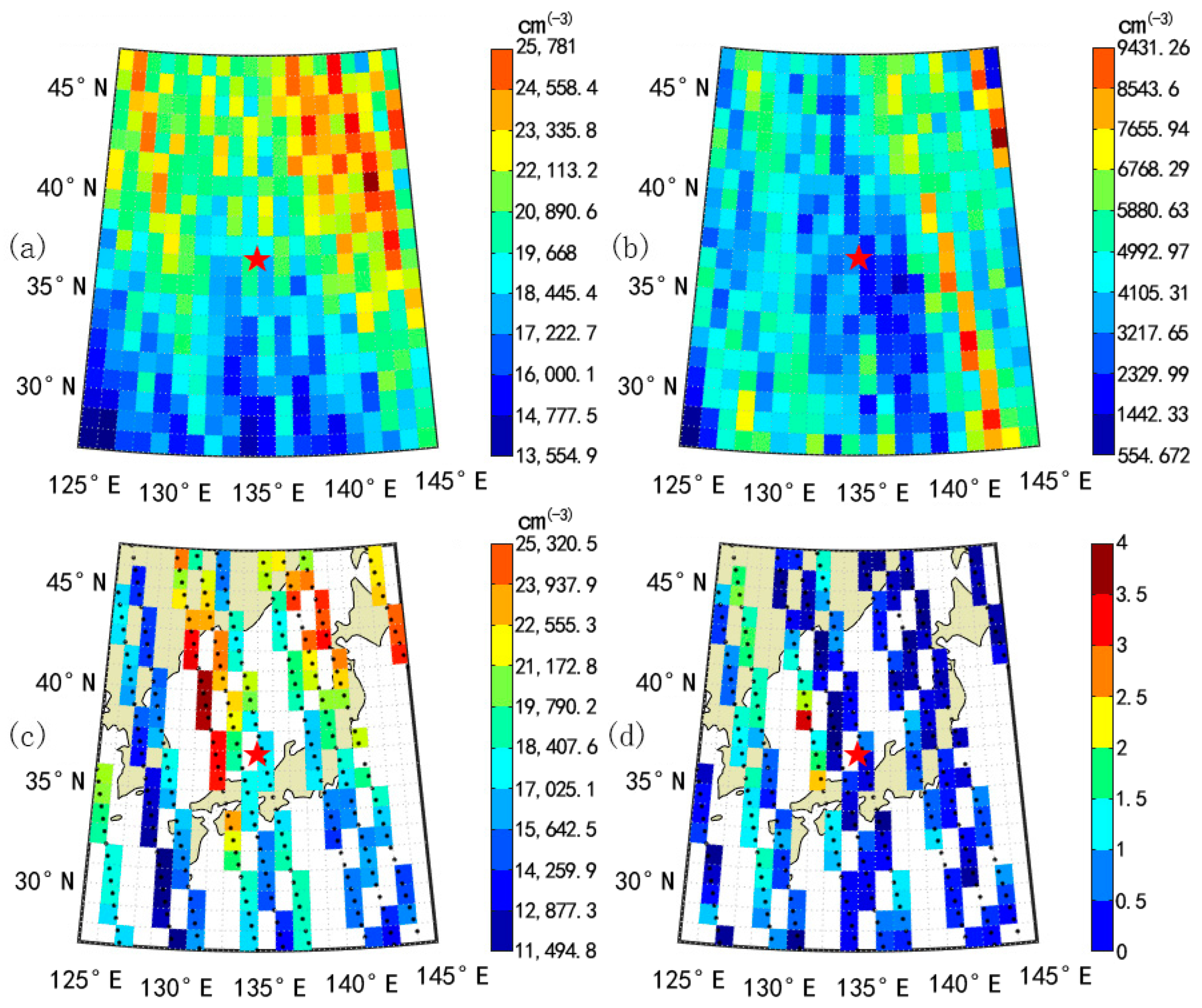
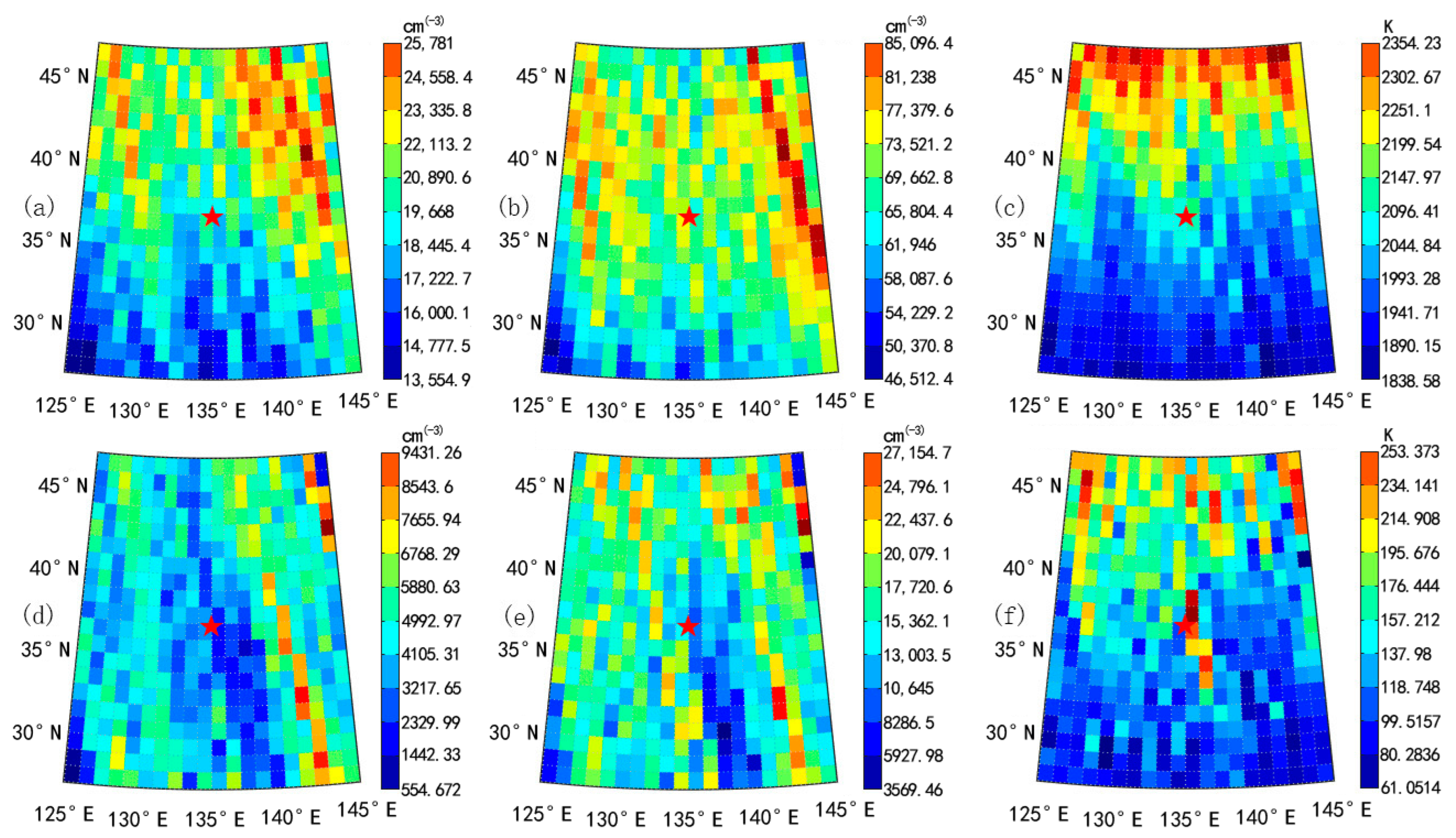
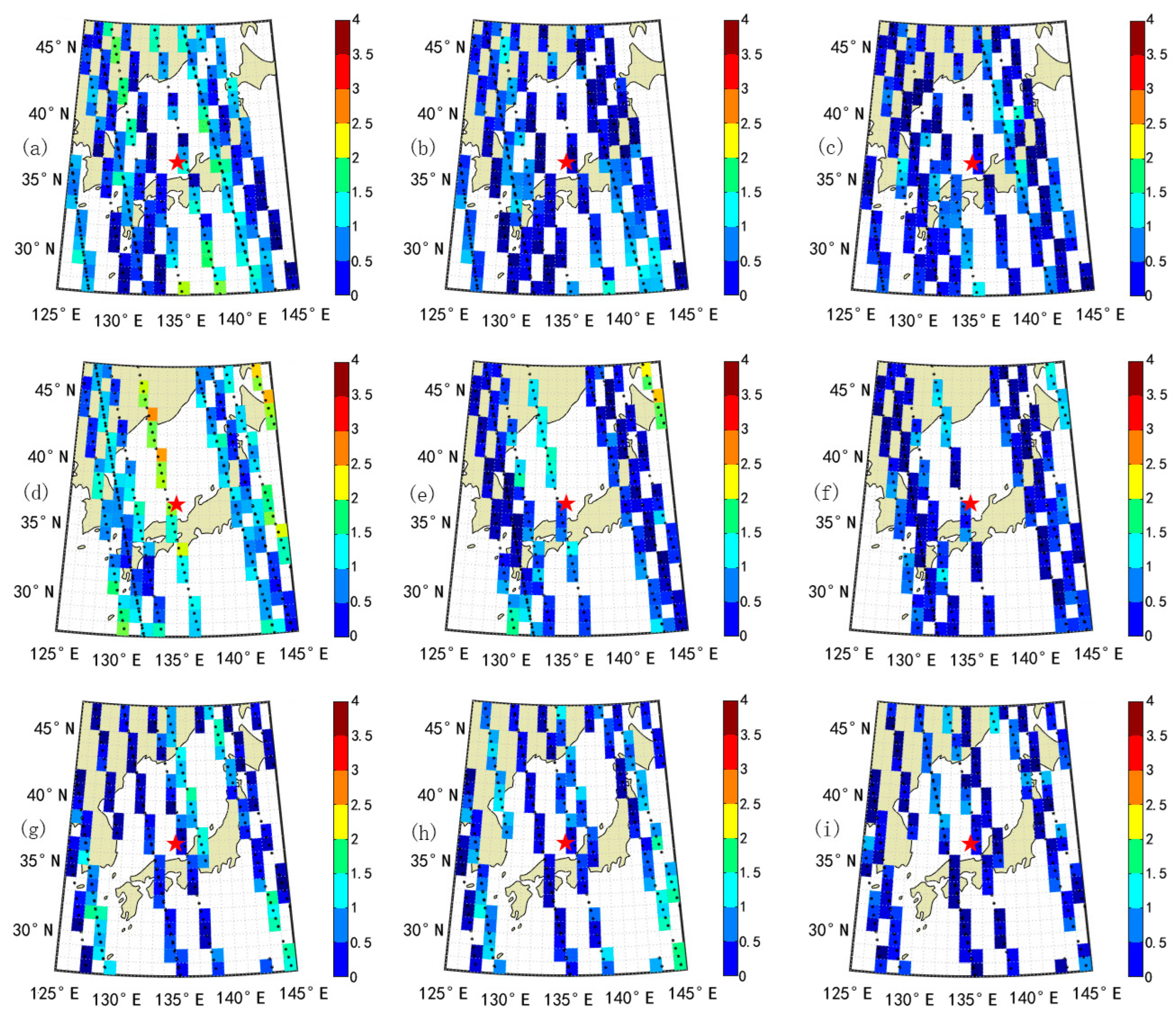
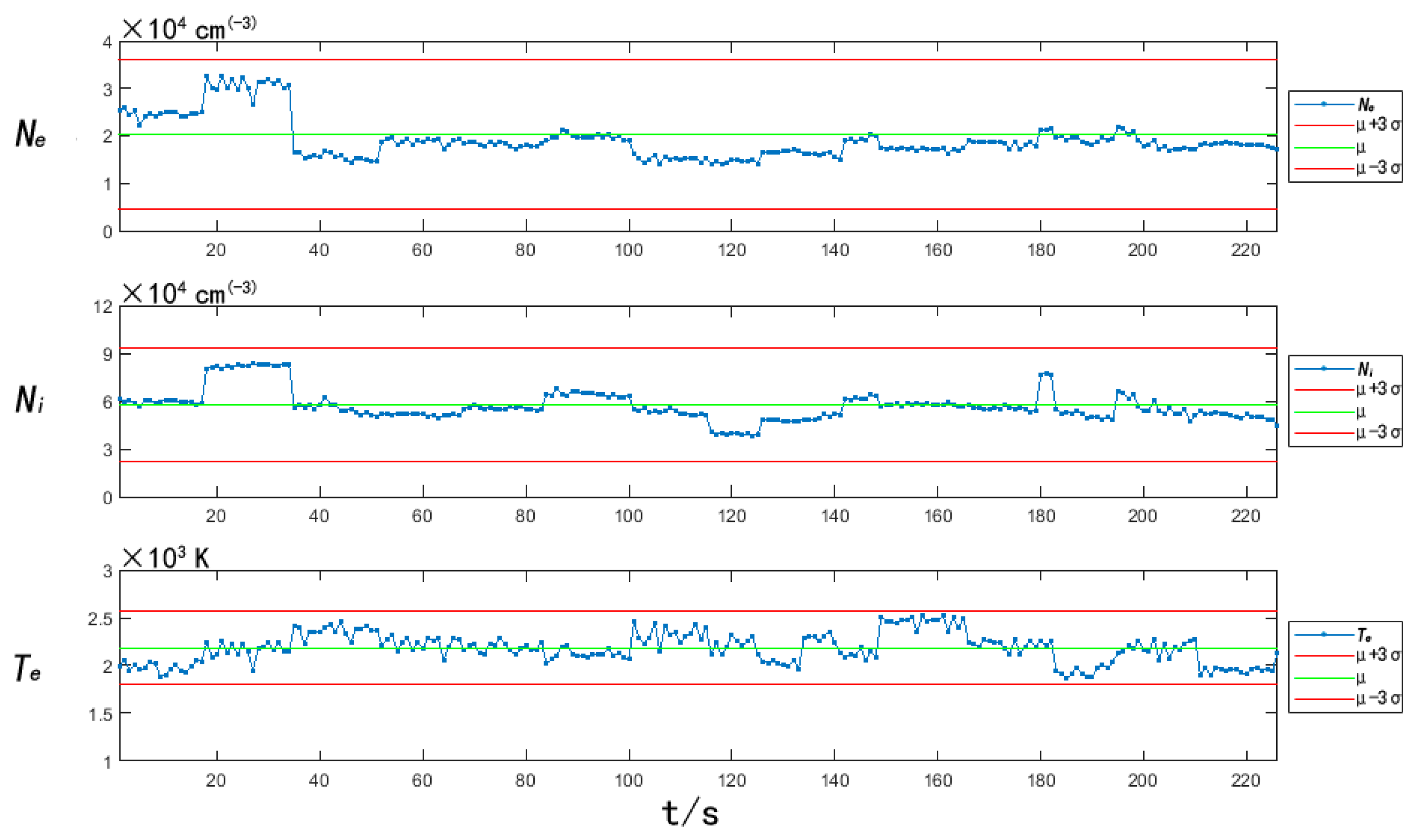


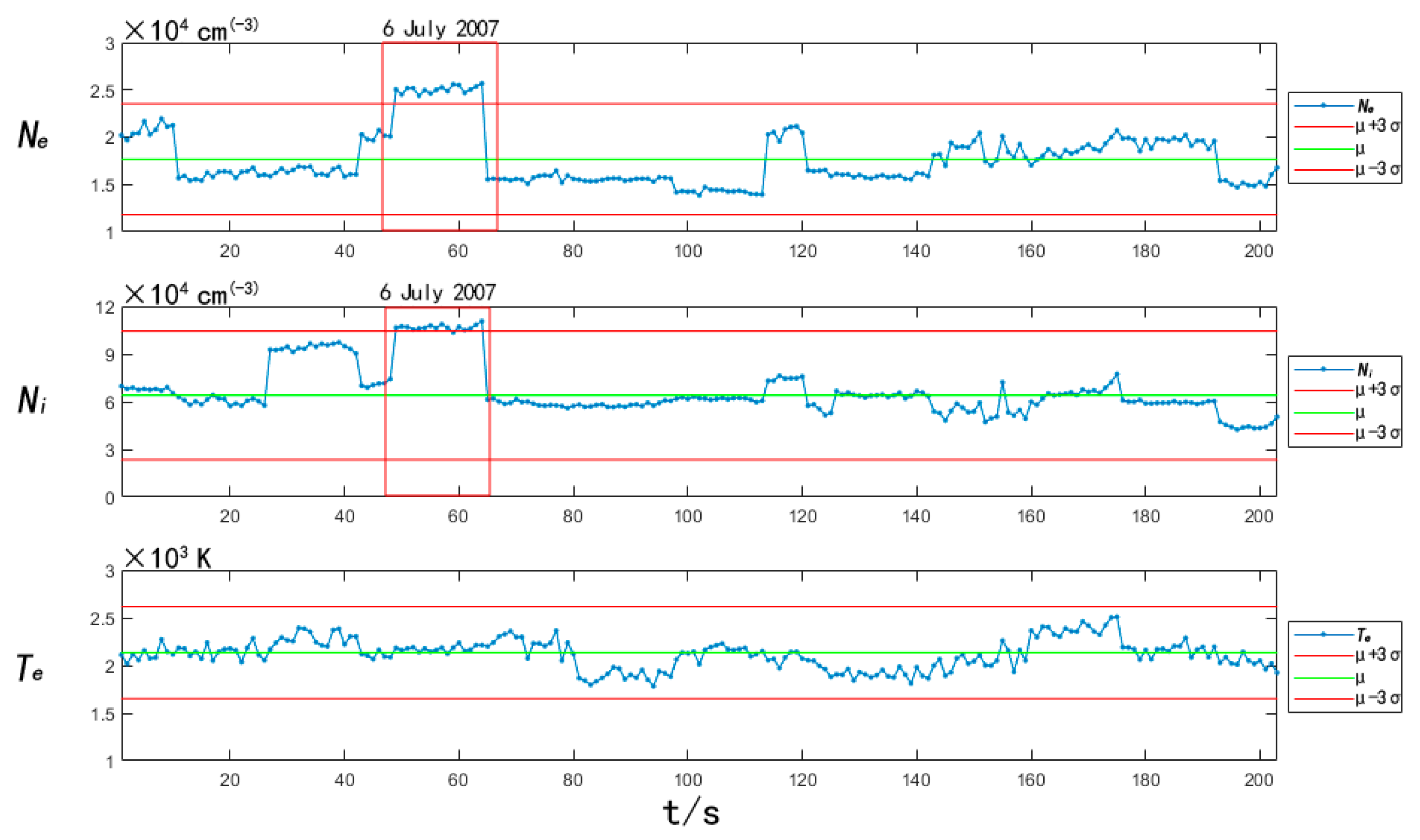
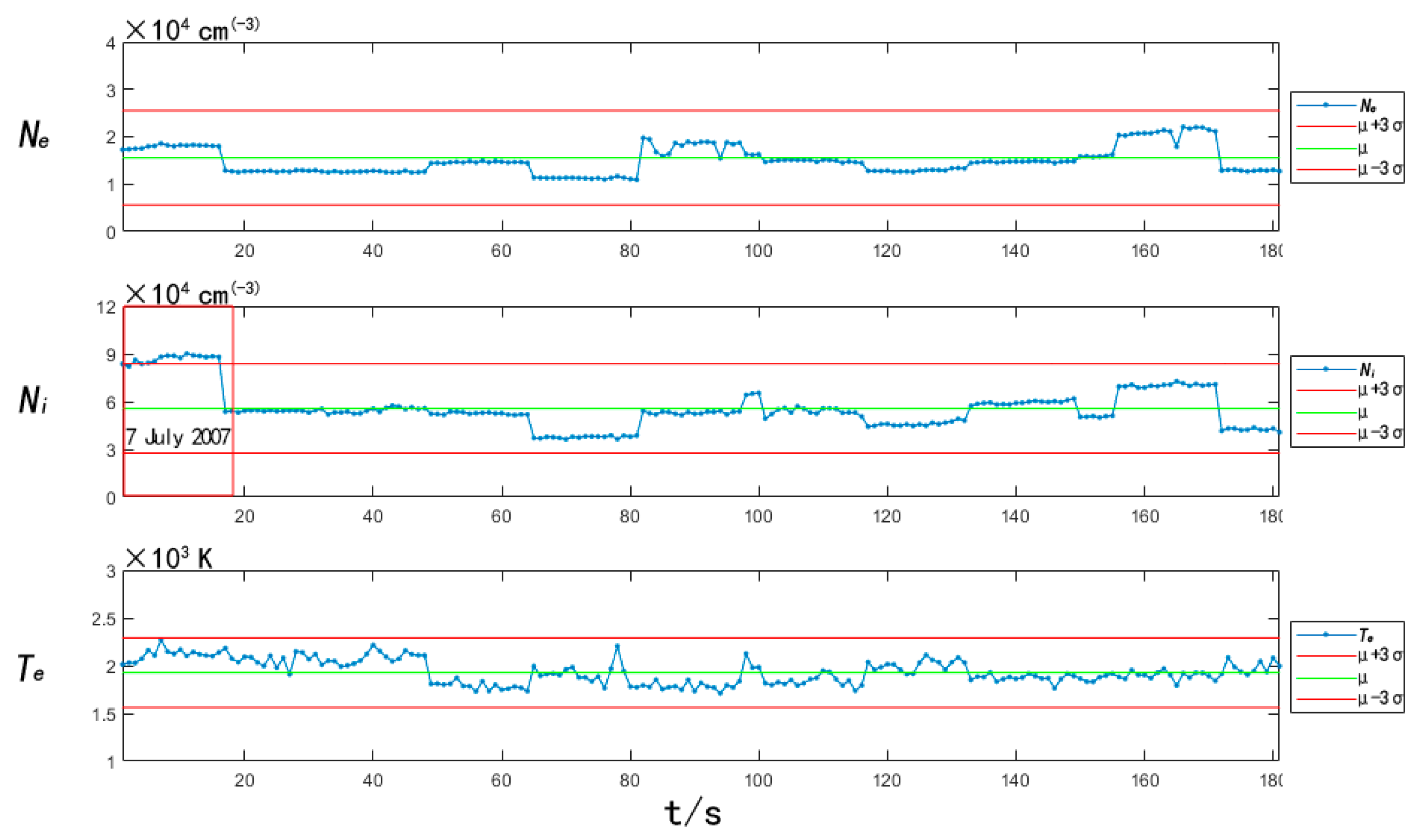
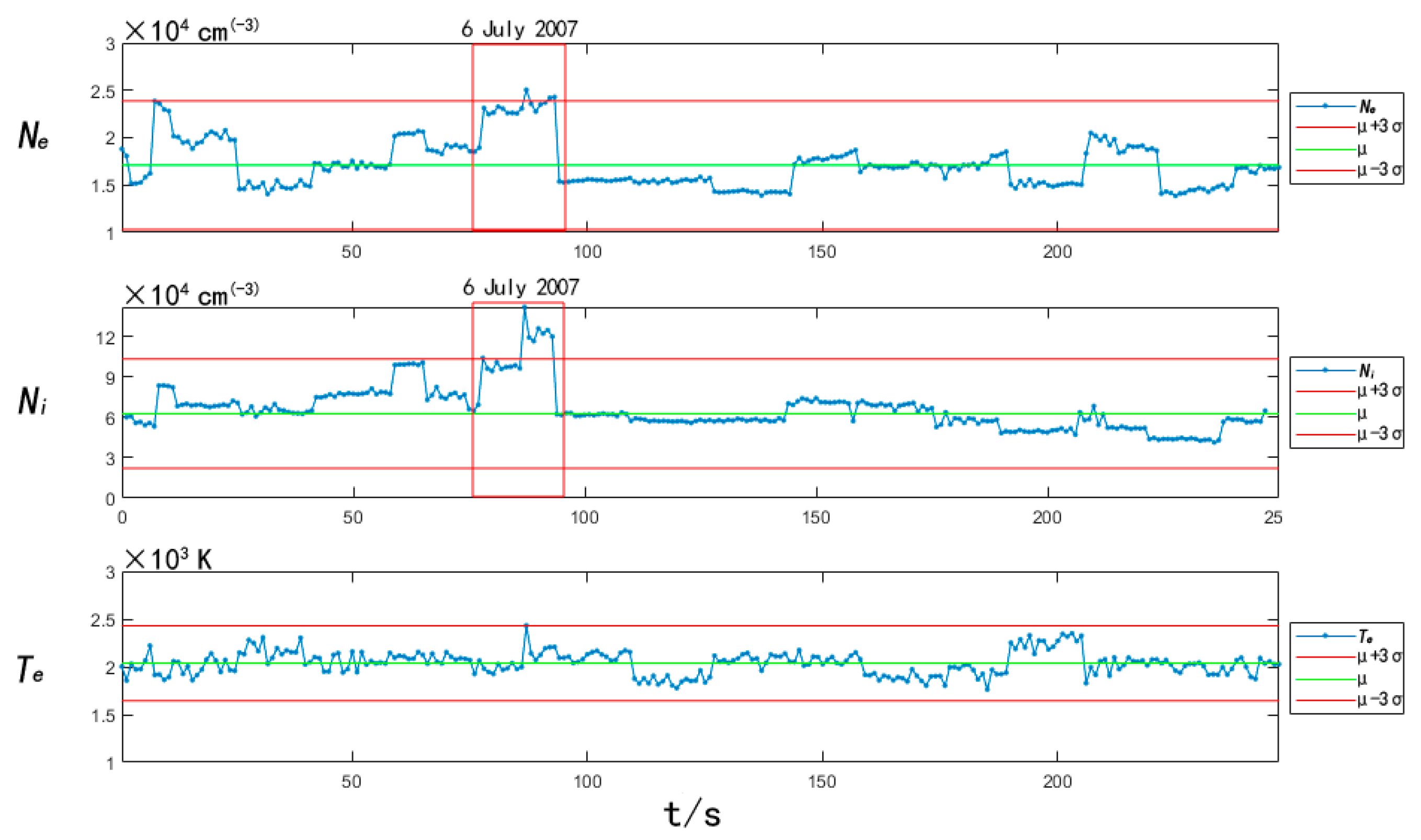

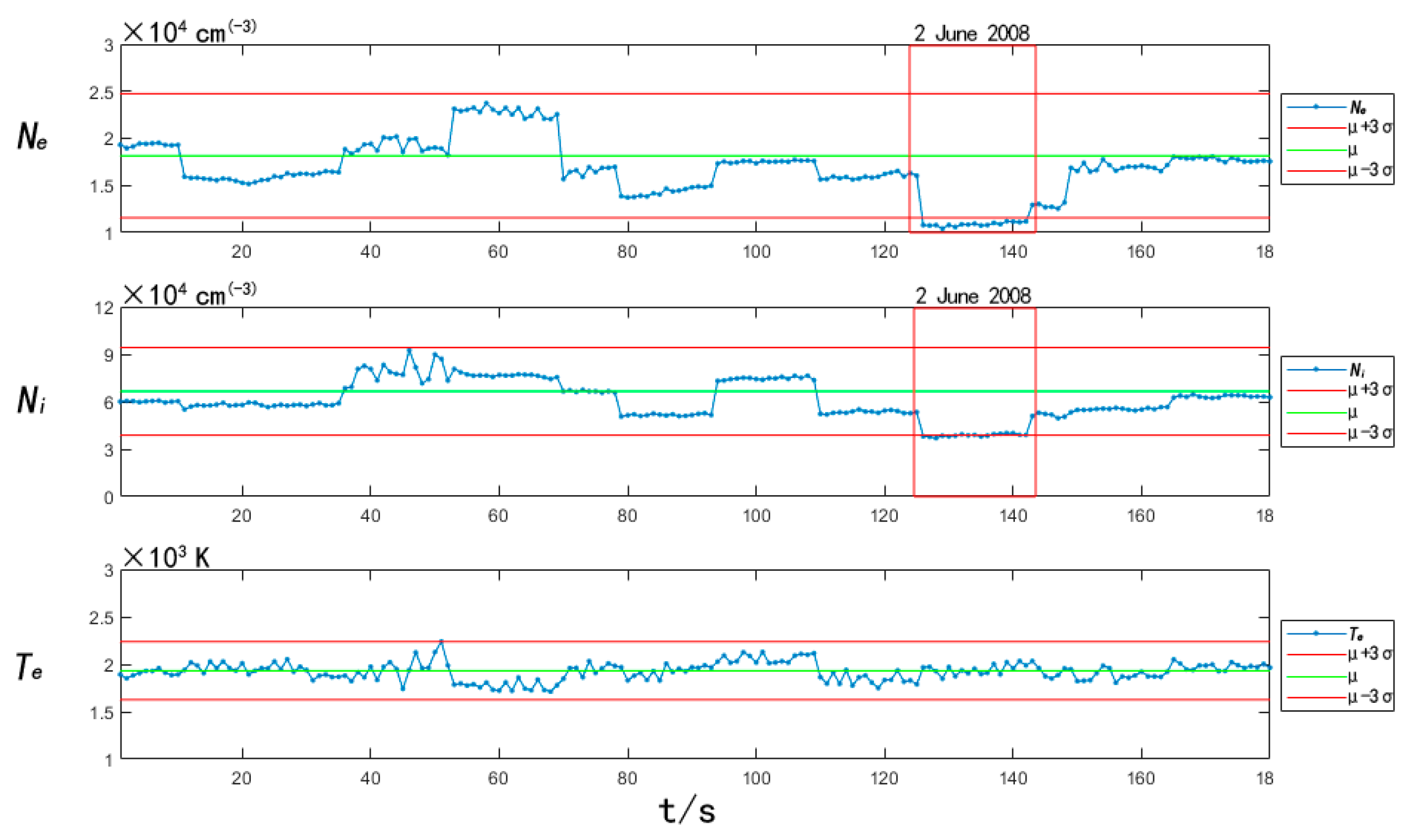
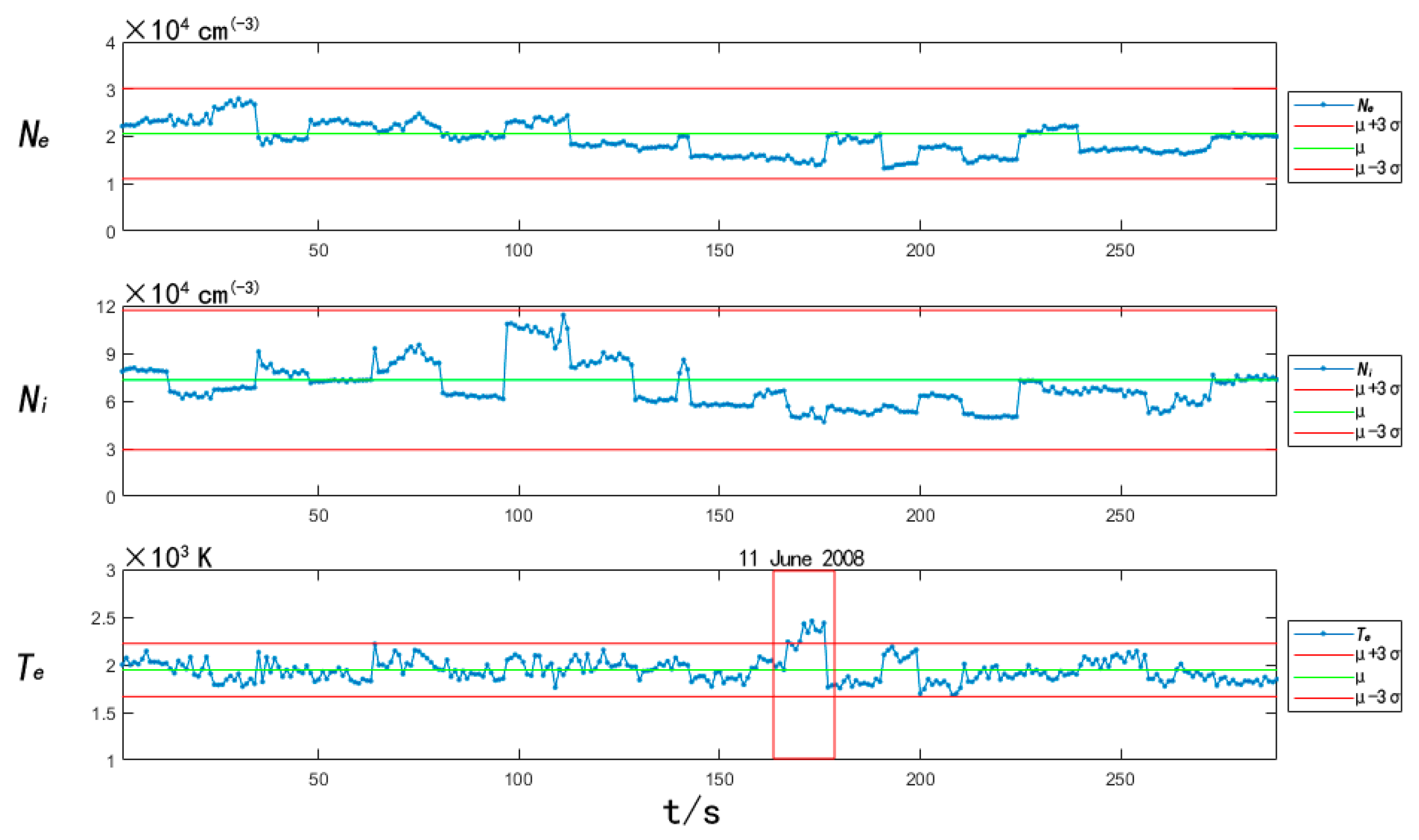

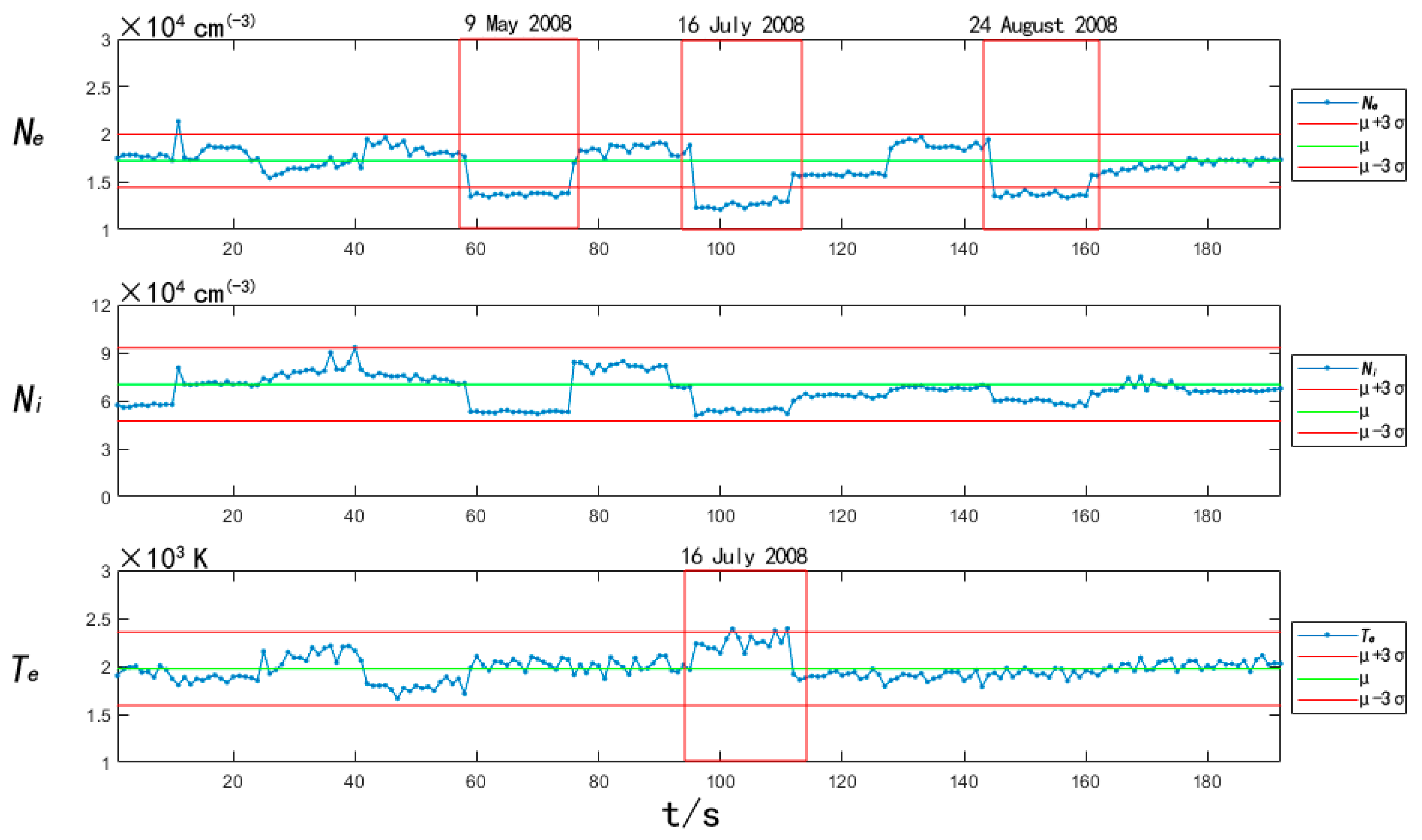
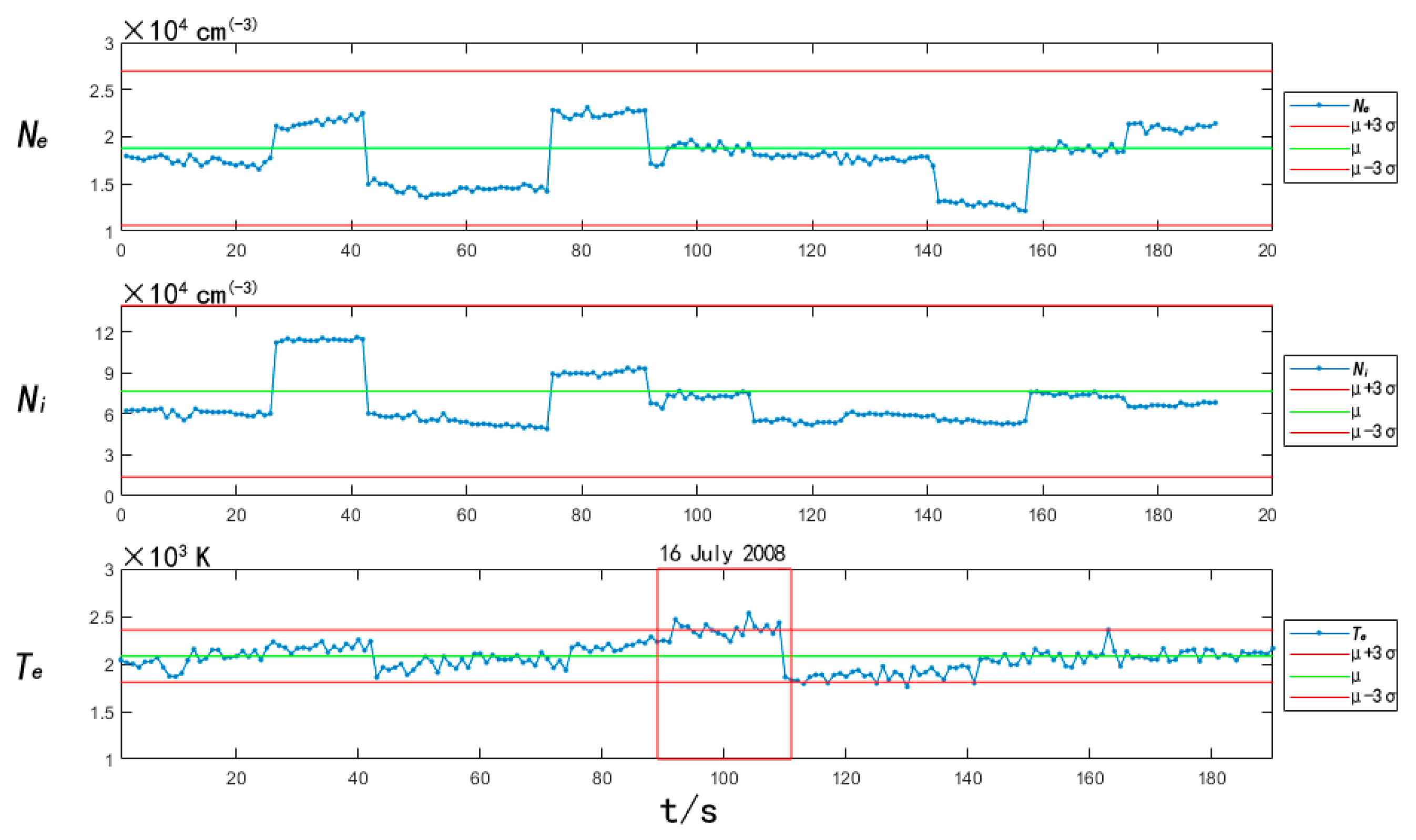

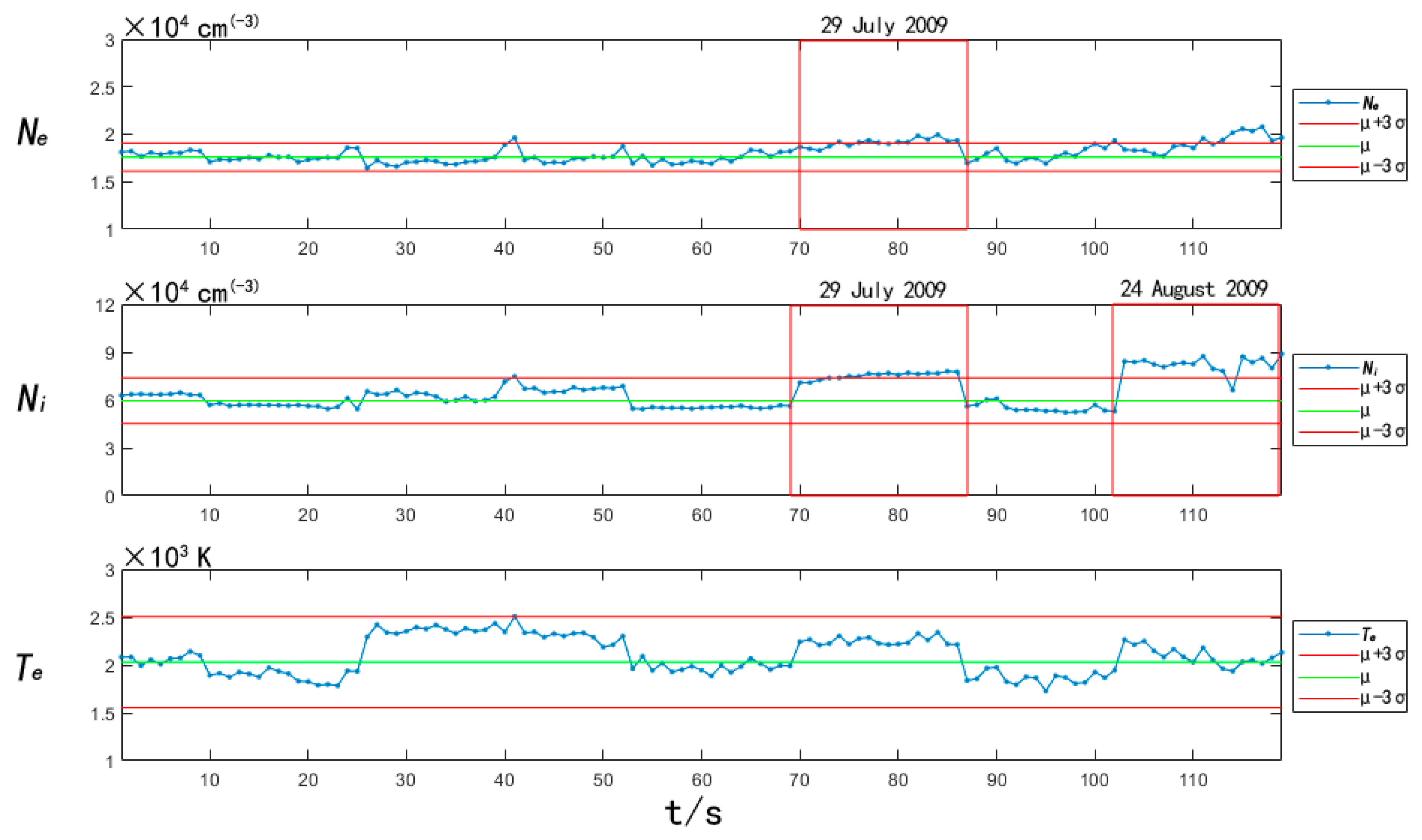
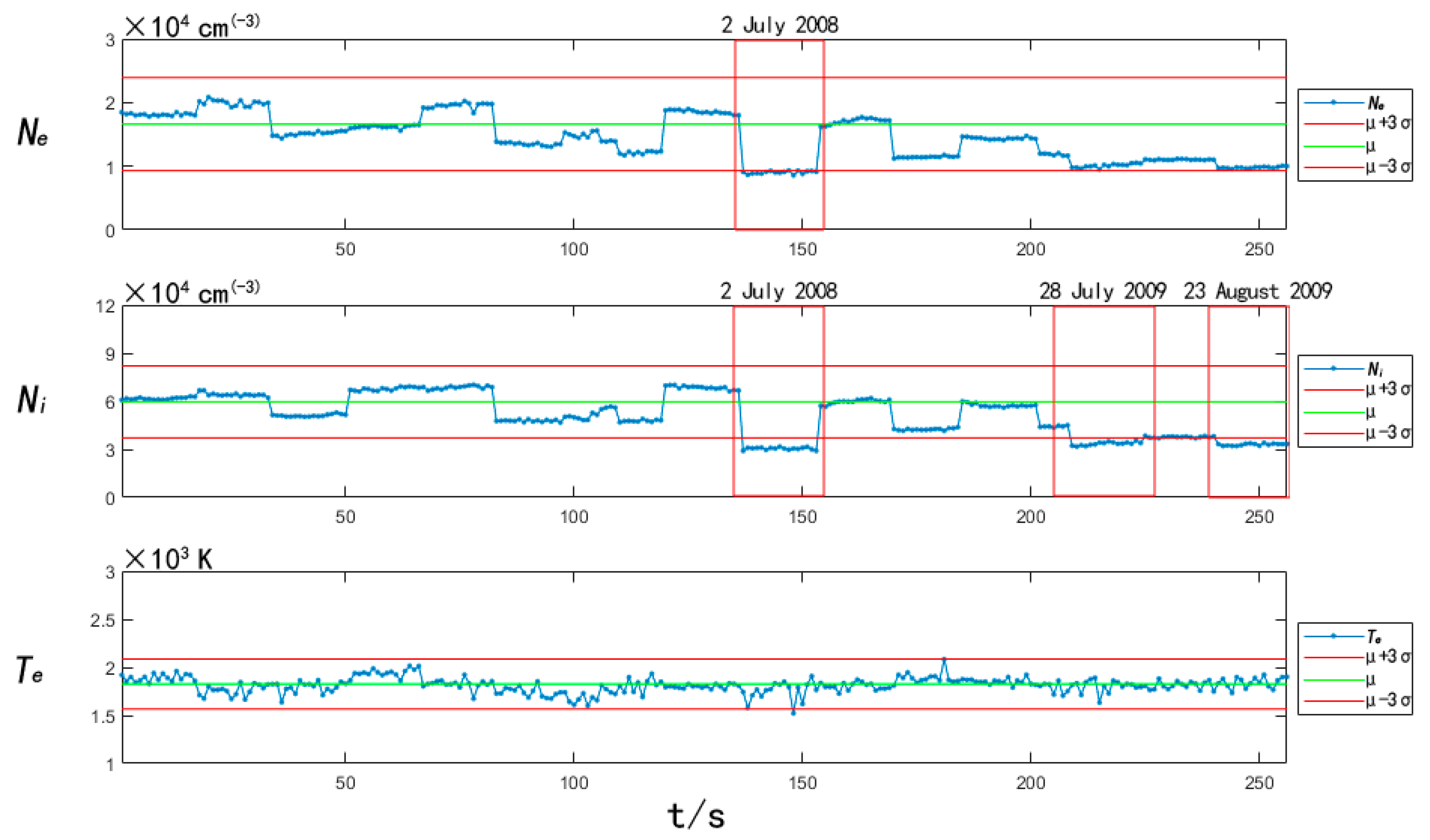
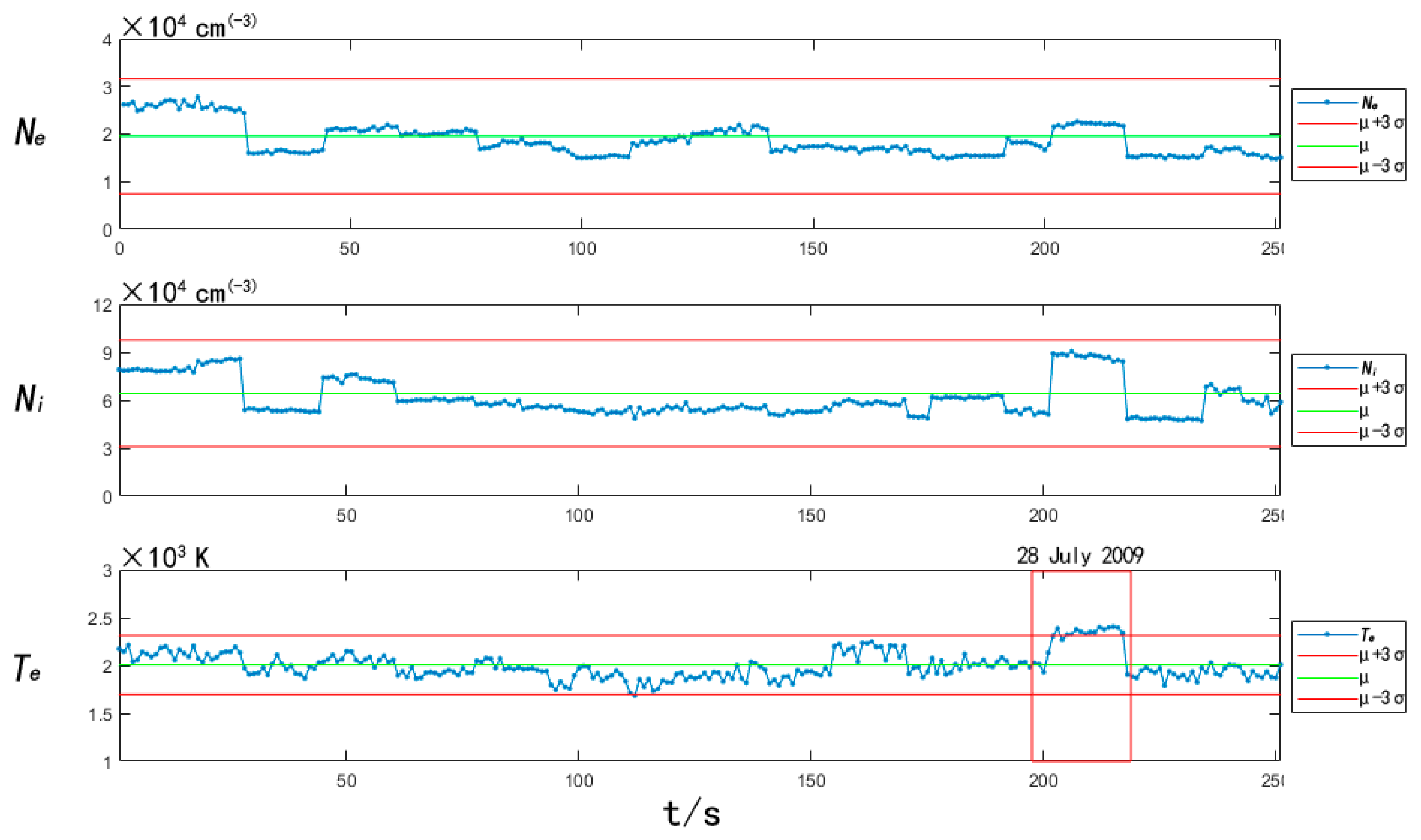
| Earthquake Number | Date | Epicenter | Magnitude | Depth/km | Space Range | Time Range | ||
|---|---|---|---|---|---|---|---|---|
| Latitude | Longitude | Start Date | End Date | |||||
| 1 | 16 July 2007 | 36.7° N, 135.2° E | 6.9 | 350 | 27–47° N | 125–145° E | 1 July 2007 | 16 July 2007 |
| 8 May 2008 | 36.1° N, 141.6° E | 7.1 | 10 | |||||
| 2 | 14 June 2008 | 39.1° N, 140.8° E | 7.0 | 10 | 29–49° N | 131–151° E | 30 May 2008 | 14 June 2008 |
| 3 | 19 July 2008 | 37.5° N, 142.3° E | 7.3 | 10 | 27–47° N | 132–152° E | 4 July 2008 | 19 July 2008 |
| 4 | 9 August 2009 | 33.1° N, 138.2° E | 7.2 | 10 | 23–43° N | 128–148° E | 25 July 2009 | 9 August 2009 |
| 13 August 2009 | 32.6° N, 140.5° E | 6.5 | 96 | |||||
| Region Number | Space Range | Corresponding Orbit | Corresponding Date | |
|---|---|---|---|---|
| Latitude | Longitude | |||
| 1 | 38–39° N | 131–132° E | 16070_1 | 6 July 2007 |
| 2 | 32–33° N | 125–126° E | 16085_1 | 7 July 2007 |
| 3 | 35–36° N | 132–133° E | 16070_1 | 6 July 2007 |
| 4 | 38–39° N | 131–132° E | 16070_1 | 6 July 2007 |
| Region Number | Space Range | Corresponding Orbit | Corresponding Date | |
|---|---|---|---|---|
| Latitude | Longitude | |||
| 1 | 32–33° N | 137–138° E | 20946_1 | 2 June 2008 |
| 2 | 36–37° N | 142–143° E | 21078_1 | 11 June 2008 |
| Region Number | Space Range | Corresponding Orbit | Corresponding Date | |
|---|---|---|---|---|
| Latitude | Longitude | |||
| 1 | 33–34° N | 149–150° E | 21592_1 | 16 July 2008 |
| 2 | 40–41° N | 147–148° E | 21592_1 | 16 July 2008 |
| Region Number | Space Range | Corresponding Orbit | Corresponding Date | |
|---|---|---|---|---|
| Latitude | Longitude | |||
| 1 | 40–41° N | 146–147° E | 27146_1 | 29 July 2009 |
| 2 | 23–24° N | 134–135° E | 27132_1 | 28 July 2009 |
| 3 | 38–39° N | 130–131° E | 27132_1 | 28 July 2009 |
| Date | Anomalies | |||||
|---|---|---|---|---|---|---|
| Epicenter | Ne | Ni | Te | |||
| Date and Type of Anomaly | Abnormal Area (Relative to the Epicenter) | Date and Type of Anomaly | Abnormal Area (Relative to the Epicenter) | Date and Type of Anomaly | Abnormal area (Relative to the Epicenter) | |
| 16 July 2007 | 6 July 2007 Abnormal enhancement | Northwest | 6 July 2007 Abnormal enhancement, 7 July 2007 Abnormal enhancement | Northwest and southwest, Southwest | No abnormalities | |
| 36.7° N, 135.2° E | ||||||
| 14 June 2008 | 2 June 2008 Abnormal weakening | Southwest | 2 June 2008 Abnormal weakening | Southwest | 11 June 2008 Abnormal enhancement | Southeast |
| 39.1° N, 140.8° E | ||||||
| 19 July 2008 | 16 July 2008 Abnormal weakening | Southeast | No abnormalities | 16 July 2008 Abnormal enhancement | Southeast and southwest | |
| 37.5° N,142.3° E | ||||||
| 9 August 2009 | 29 July 2009 Abnormal enhancement | Northeast | 28 July 2009 Abnormal weakening, 29 July 2009 Abnormal enhancement | Southwest, Northeast | 28 July 2009 Abnormal enhancement, 29 July 2009 Abnormal enhancement | Northwest, Northeast |
| 33.1° N, 138.2° E | ||||||
Disclaimer/Publisher’s Note: The statements, opinions and data contained in all publications are solely those of the individual author(s) and contributor(s) and not of MDPI and/or the editor(s). MDPI and/or the editor(s) disclaim responsibility for any injury to people or property resulting from any ideas, methods, instructions or products referred to in the content. |
© 2023 by the authors. Licensee MDPI, Basel, Switzerland. This article is an open access article distributed under the terms and conditions of the Creative Commons Attribution (CC BY) license (https://creativecommons.org/licenses/by/4.0/).
Share and Cite
Lu, J.; Hu, Y.; Jiang, C.; Zhao, Z.; Zhang, Y.; Ma, Z. Analysis of Pre-Earthquake Ionospheric Anomalies in the Japanese Region Based on DEMETER Satellite Data. Universe 2023, 9, 229. https://doi.org/10.3390/universe9050229
Lu J, Hu Y, Jiang C, Zhao Z, Zhang Y, Ma Z. Analysis of Pre-Earthquake Ionospheric Anomalies in the Japanese Region Based on DEMETER Satellite Data. Universe. 2023; 9(5):229. https://doi.org/10.3390/universe9050229
Chicago/Turabian StyleLu, Jingming, Yaogai Hu, Chunhua Jiang, Zhengyu Zhao, Yuannong Zhang, and Zhengzheng Ma. 2023. "Analysis of Pre-Earthquake Ionospheric Anomalies in the Japanese Region Based on DEMETER Satellite Data" Universe 9, no. 5: 229. https://doi.org/10.3390/universe9050229
APA StyleLu, J., Hu, Y., Jiang, C., Zhao, Z., Zhang, Y., & Ma, Z. (2023). Analysis of Pre-Earthquake Ionospheric Anomalies in the Japanese Region Based on DEMETER Satellite Data. Universe, 9(5), 229. https://doi.org/10.3390/universe9050229







